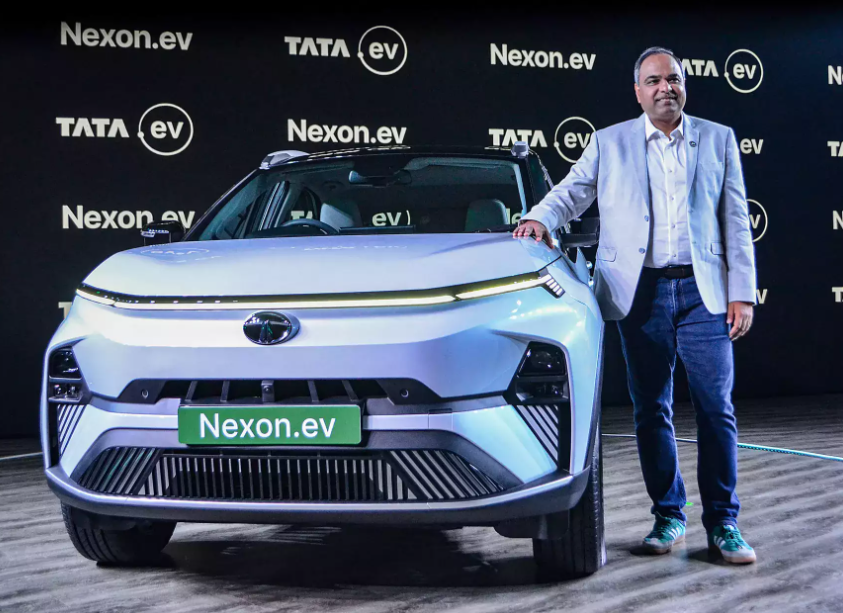
New Delhi: As far as Shailesh Chandra is concerned, there is absolutely no question about the fact that electric is the right way forward for the Indian automobile industry.
The Managing Director of Tata Motors Passenger Vehicles and Tata Passenger Electric Mobility is clearly exasperated that there is still so much debate underway on alternative clean fuel options when it is crystal clear that they are not going to meet the intended objectives.
“I continue to believe in electric vehicles because every nation and every stakeholder has a task towards net zero carbon. This is the north star for any country to protect the planet and that is the right way forward,” reiterates Chandra.
Different industries may have their own challenges to move towards that path and in the process adopt certain technologies that help in meeting the net carbon zero goal. “Fortunately in cars, we have EVs which are viable and give you the pathway towards net zero carbon,” he says.
Is there any other option? The only one would be another zero emission vehicle. As Chandra puts it, “There is no other option for any industry but to move towards that. Some can move fast, some will have to wait with more investments.”
Staying on course
This is where the growing global debate on the merits of EVs raises his hackles. “If our industry is so fortunate to have a zero emission technology today, why should we digress? I don’t think any country would shift away (from zero emissions technology) if they have to be on the course of net zero carbon commitments,” he says.
The same pressure will extend to all companies and today there are more options in electric for customers. Barriers have been removed further and prices are down but the EV story is going up and down across different geographies for a host of other reasons like “sponsored anti-EV commentary”.
Chandra makes no bones about the fact that the only thing that has gone wrong is this negative commentary that is spreading like wildfire and making it seem as if EVs are catastrophic for carmakers.
“Every small inventory buildup in the US is being exaggerated. If a traditional OEM launches a product and it does not succeed, it is seen as a mega trend if inventory piles up,” he says. This happens in the ICE (internal combustion engine) world too where four out of ten products could fail and there is inventory buildup as a result.
Gloom and doom
In Europe, there was a slight slowdown because subsidies were brought down. China, likewise, reduced subsidies and in the US, some big manufacturers saw pileup of inventory following EV product failure. “All these small cases of the glass being half empty are shown as a gloom and doom scenario,” says Chandra.
He believes that there are more naysayers today who make it a point to constantly talk negatively about EVs. “Despite this gloom and doom, I am confident because there is no other path for the auto industry towards net zero carbon unless another viable alternative of zero emission technology comes in the space,” he says.
Electric is the only answer today and as far as CNG, hydrogen, biogas etc are concerned, they are technologies which have to “come on their own” to meet emission norms. If this segment of ICE vehicles is present in the transition phase — “unless you get into the full zero emission situation for industry” — it should be penalised if it does not bring down emissions.
Manufacturers then need to use certain technologies to bring down emissions be it CNG, hybrid etc and these will have to be introduced depending on how their tech is progressing. They would not need these if they are heading rapidly towards EVs because “you are then on course” in meeting the eventual objective.
Negative commentary
“On the other hand, if you are late, you bring in hybrids. Because you are late in electric, you are putting a negative commentary (on electric) and I believe that today you can delay the process. However, net zero carbon pressure is a reality and every industry has to comply (with this goal),” cautions Chandra.
The pressure of transparency on every company — to show how they are working on net carbon zero as a combined but differentiated responsibility — is an ownership “which will intensify on nations” and corporate houses. “It is better that you be fast on that, otherwise you will face the pressure. You could be in denial mode but eventually it will hit you,” he says.
Chandra also wonders why people have started talking hybrids in India when it is a two decades-old technology? Why didn’t they talk about this in 2015? Is it because of the CAFE (corporate average fuel efficiency) penalty? “In CAFE, you are not able to meet the requirement because you are late in electric and thereby forced to do a hybrid,” he elaborates.
Else with CNG, petrol and without diesel there is no other way of meeting CAFE 2. And in CAFE 3, “your life becomes even more difficult because you are late”. Today, without CNG and hybrid, Tata Motors has a headroom of 20 gram per km. When the requirement is 118-119 gm/km, the company is reporting 95 gm. This also means that when CAFE trading comes in, “I can trade this for money”.
Latecomers going regressive
Therefore, any other company which is going fast on electric will never need the technology. “But somebody who is late (in electric) is trying to regress the country towards 20-year-old technology. When the world is leapfrogging into electric, you want to regress the whole country because you are not ready,” says a visibly irked Chandra reacting to the hybrid lobby.
From his point of view, for the same demand opportunity across all OEMs, “you want them to spread their investments everywhere” and not focus on the technology which is the destination technology. “You make everybody work on intermediate technology because you are not ready and therefore you start comparing a hybrid to an electric. Electric comparison can only be done with a technology which is zero emission or where the source of energy is electricity,” he maintains.
Chandra is clearly annoyed and this irritation comes through in the conversation especially when it comes to comparing a hybrid whose 100% source of energy is a petrol engine. “How can you even compare that to electric? Because you have a motor or a 0.5 kWh of battery? Does that make you electric? No! Because it is a delivery of the power that you are giving to the wheels through that mechanism,” he adds forcefully.
Essentially, continues Chandra, “you are using petrol” to power as the source of energy…the battery and motor are being used to optimise the fuel use. It is as good as diesel or CNG. Then why seek a subsidy, he asks.
Penalising taxpayers
“My problem is not with hybrids..please sell hybrid to meet compliance needs and if customers are ready to buy it, sell it. But you cannot be taking taxpayers’ money for that..it is not a destination technology,” affirms Chandra.
Tomorrow, if CAFE 4 norms become so stringent that for “every ICE vehicle I sell I will need a hybrid, I will do that but I will not ask for taxpayers’ money”. As far as he is concerned, ICE technology only has to be penalised now and cannot be incentivised. Incentives, on the other hand, should be only to one destination technology— electric in this case — so that its progress continues to gain momentum and is not hindered by these needless distractions.
“If you shift anything towards ICE technology, this slows down,” warns Chandra. And even while Tata Motors also has a CNG portfolio, it is opposed to any duty cut on this fuel (in the case of two-wheelers, the idea of seeing GST reductions on CNG is to spread its use).
A customer pays more for CNG than a petrol car because of the running cost benefits. Fuel is subsidised too and it is a high fuel efficiency engine. “Therefore, I make more margins on CNG than petrol…then you ask for a subsidy? Where will that go? That is not done and the same applies to hybrids also,” says Chandra.
By the end of the day, the math just does not add up since “you make more money and you ask the Government to subsidise” so that every effort on electric gets killed. The Centre is contributing by way of lower GST and “I am sacrificing my margins” to make electric viable and then money is being diverted elsewhere. “That is the problem I have with hybrid,” says a candid Chandra.
Divided house
Reports have also been doing the rounds that the Society of Indian Automobile Manufacturers is a divided house with a section batting for hybrids while the other members want to focus on electric. From Chandra’s point of view, there are bigger things to worry about right now in terms of keeping a priority list in place.
“We have declared our net carbon zero aspiration by 2040 and have also signed as an organization the SBTi (Science Based Targets Initiative). We are liable to report every year how we are progressing on the net zero carbon goal.We have stuck our neck out and said we want to do this,” he explains. Eventually, every company will be forced to do this because they will be asked tough questions by investors, activists, customers etc.
Solar magic
Interestingly, Tata Motors is asking EV buyers to put solar rooftops that offer the net zero carbon benefit. Nearly 95% of the time, electric cars are charged at home and with a solar rooftop, this whole debate of 75% thermal mix coming from the grid is demolished.
In a recently carried out survey of its 10,000 EV buyers, 30% said they already have solar rooftops and this component will only increase in the future. If this reaches 50% in the next 2-3 years, the grid mix of 75% becomes 37.5% thermal for EVS.
If the grid mix becomes 50:50 by 2030, 80% would be renewable. “Shift everybody to solar and the electric car then becomes such a viable proposition,” says Chandra. Both the car and home energy costs will plummet and such steps needs to be taken on a war footing.
“This is how we need to face the future where we can do our bit as individual stakeholders in different industries and become responsible. Only then will the country move ahead,” he adds. Going forward, 2030 will be tough when climate activists get on to the stage. “This company will not be in a situation that if any new technology comes in, we will be left behind,” asserts Chandra.
















